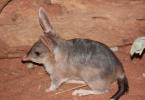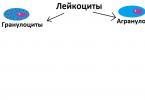This bilby, aka - rabbit bandicoot, or long-eared marsupial badger, or common bilby (lat. Macrotis lagotis) is a species of marsupial mammal from the family of rabbit bandicoots (Thylacomyidae).
Lives in Australia. It feeds on insects, larvae and rodents. Breeds in autumn. The offspring are small (1-2 cubs). It has beautiful long silky fur, the trade of which, in addition to low fertility, has led to the scarcity of this species.
Bilbies are distinguished from other bandicoots by their long, silky bluish-gray fur, very long, rabbit-like ears, and also a long, well-furred tail; the very tip of the tail is hairless, and the entire tail is sharply two-colored (black at the base and white at the tip).
The molars are large, in adults - with a completely smooth concave surface; in this they differ from the sharp-tubercated native bandicoots. In terms of their lifestyle, bilbies are also different from all other members of the family: they dig deep holes, consume large amounts of meat food and are nocturnal. It is almost equal in size to an adult rabbit, which is why it is sometimes called a bilby rabbit.


The bilby sleeps in a strange position: crouched on its hind legs and with its muzzle tucked between its front legs. The bilby has a mixed diet: it eats insects and their larvae, as well as small mammals, such as mice. Its fangs are strong, like those of cats, and the animal can strongly bite someone who carelessly touches it.
Otherwise, he is not at all aggressive towards humans. Hunts at night, mainly using smell and hearing; vision is poorly developed. Bilbies live in pairs, each pair in their own burrow. Reproduction occurs in autumn (March to May). In contrast to real rabbits, bilbies are not fertile: usually there are no more than one or two young in a brood, although the female has 8 teats on the milky field. The bag opens down and back.




The burrow is the bilby's best defense. To dig, the bilby uses its front paws with wide claws and the bare tip of its tail, which it uses to level the dirt that accumulates behind it. The burrow quickly spirals downwards to a depth of 1.5 m and even deeper. There is no second outlet. The animal lives in the very depths of the hole, and it is difficult to remove it from there. If, having established that the bilby is in a hole, you begin to tear it apart with a shovel, then the bilby also digs in the opposite direction with such speed that it is impossible to catch it.
Aboriginal people value the pelt and skin of the bilby. His black and white tail is their favorite decoration. At the beginning of colonization, the bilby was widespread in the southern half of the Australian mainland. Probably, the aborigines, even before the arrival of Europeans, partially exterminated this infertile animal.
Over the last hundred years, its range has especially decreased, as the fight against rabbits (traps, poisoned baits) has simultaneously undermined the bilby's numbers.



The fox brought to Australia also actively destroys it. Bilby skins were at one time traded in Adelaide markets. The bilby has now disappeared from all populated areas except the south-western part of Western Australia. In addition, it is rarely found in semi-deserts, which are unsuitable for its existence.
Interesting fact:
In January 2011, the Australian Mint released the fourth coin in its amazingly beautiful Australian Bush Babies series, featuring a bilby. Previously released coins were dedicated to the baby kangaroo, sugar glider and dingo.

On the obverse of the coins there is a portrait of Queen Elizabeth II, “ELISABETH II AUSTRALIA 2010”. The reverse features a beautiful little bilby with sparkling eyes in color. Artist Elise Martinson was able to convey the innocence and tenderness of the little creature in such a way that it is impossible to tear yourself away from the coin. The reverse background reflects the features of the bilby's habitat and the features of “friendly” Australian insects.
The rabbit bandicoot (lat. Macrotis lagotis) is one of the rarest marsupial mammals. It differs from other representatives of the Bandicoot order (Peramelemorphia) in its extraordinary desire for the construction of underground structures and addiction to food of animal origin.
The bandicoot digs holes so quickly that it is almost impossible to catch it even with a shovel. It will easily give a huge head start to even the most experienced and fastest digger. For this reason, its two-colored (black at the base and white at the end) tail with a bald tip has long been highly valued among the Australian Aborigines. The owner of such a treasure is considered a dexterous, cunning person and enjoys well-deserved authority in his native tribe.
Rabbit bandicoot meat is edible and was consumed by European settlers.
They hunted it not with a digging stick, but with the help of firearms, so by the end of the 19th century, the previously numerous animals became significantly smaller. Foxes and dogs brought from Europe also contributed to the extermination of rare animals. At one time in Australia, the silky fur with a bluish tint of the eared handsome man was very popular and was quite expensive. It was called Bilby rabbit fur.
Behavior
Just a hundred years ago, rabbit bandicoots were found on 70% of the Australian continent, inhabiting forests, savannas and bushes. Now small populations have survived only in desert and semi-desert areas, mainly in the western regions of Australia.
The animal is active at night and sleeps during the day in a hole dug with its own hands.
The shelter, up to 2-2.5 m deep, has one entrance hole and a spiral shape. During sleep, the bandicoot does not lie down, but sits on its hind legs, placing its muzzle between its front legs and covering its eyes with its long ears. It goes out in search of food at dusk, moving around the surrounding area in small jumps.

Most bandicoots lead a solitary lifestyle, but married couples are also often found. On one home site, one animal can dig up to 12 underground shelters, in which it rests alternately.
The rabbit bandicoot is omnivorous. It digs up food with its strong front paws. The diet consists mainly of insects and their larvae, worms and roots of various plants. The necessary moisture is obtained from food, so representatives of this species may not drink water at all for a long time.
Reproduction
Previously, these marsupials, living in more favorable conditions with seasonal changes in climatic conditions, reproduced from March to May. Now in dry areas they breed all year round.

Pregnancy lasts about 14 days. The female brings one or two babies. Newborns are very small and helpless, like all marsupial mammals. They stay in the bag for up to two weeks. Females become sexually mature at the age of 180-220 days, and males at 270-420.
Description
The body length of adult individuals ranges from 29 to 55 cm. The tail length is 20-29 cm. The weight reaches 0.6-2.5 kg. Males are much larger than females.

The fur is long and silky. The upper part of the body is colored blue-gray, and the lower part is light gray. The head is elongated, the snout is pointed and hairless. The ears are long. The front paws are armed with strong claws. The hind legs are longer than the front legs and are adapted for jumping.
The lifespan of rabbit bandicoots in natural conditions is not precisely known. In captivity, with good care, they live up to 7 years.

- Class: Mammalia Linnaeus, 1758 = Mammals
- Infraclass: Metatheria Huxley, 1880 = Marsupials
- Order: Marsupialia Illiger, 1811 = Marsupials
- Family: Thylacomyidae = Rabbit bandicoots
- Species: Macrotis leucura Thomas, 1887 = Lesser rabbit bandicoot
Species: Macrotis leucura Thomas, 1887 = Lesser rabbit bandicoot
Range: The Lesser Rabbit Bandicoot is native to Central Australia. It can be found in forests, savanna, shrub meadows, grasslands, desert and other plant communities.
 The small rabbit bandicoot has a body weight from 300 to 1600 g, with an average of 354 g. The rabbit bandicoot is characterized by sexual dimorphism: males are larger than females. The body length of males ranges from 365-440 mm, the body length of females ranges from 320 to 390 mm. Lesser rabbit bandicoots have tails ranging from 115 to 275 mm long, and a pouch that opens downwards and backwards. The upper surface of the body is painted in a light color, usually gray, and the lower surface is white. The tail is white, with gray lines running towards the back of the body. The Lesser Rabbit Bandicoot also has very long, pointed, rabbit-like ears. A unique feature of the lesser rabbit bandicoot is their legs, which bear three thick toes with curved claws, the remaining two toes are very small. Their hind legs have only three toes. The first toe consists of the fused second and third toes. The second finger is very large, and the last finger is medium-sized, the first finger is missing.
The small rabbit bandicoot has a body weight from 300 to 1600 g, with an average of 354 g. The rabbit bandicoot is characterized by sexual dimorphism: males are larger than females. The body length of males ranges from 365-440 mm, the body length of females ranges from 320 to 390 mm. Lesser rabbit bandicoots have tails ranging from 115 to 275 mm long, and a pouch that opens downwards and backwards. The upper surface of the body is painted in a light color, usually gray, and the lower surface is white. The tail is white, with gray lines running towards the back of the body. The Lesser Rabbit Bandicoot also has very long, pointed, rabbit-like ears. A unique feature of the lesser rabbit bandicoot is their legs, which bear three thick toes with curved claws, the remaining two toes are very small. Their hind legs have only three toes. The first toe consists of the fused second and third toes. The second finger is very large, and the last finger is medium-sized, the first finger is missing.
The Lesser Rabbit Bandicoot breeds between March and May. The gestation period is 21 days. The lesser rabbit bandicoot has a pouch in which the young remain for 70 to 75 days. Here they are breastfed, and they seem to be attached to one of the mother's nipples during this entire time. Fourteen days after emerging from the pouch, the young begin to wean from breastfeeding. In a litter, as a rule, there are from 1 to 3 newborns. Mating occurs again 50 days after the birth of the cubs.
Behavior. The lesser rabbit bandicoot is a terrestrial, nocturnal desert mammal. They sleep sitting up, unlike other animals. The lesser rabbit bandicoot sits on its hind legs with its muzzle between its legs, its long ears lowered over its eyes, and in this position they sleep. Due to poor eyesight, the lesser rabbit bandicoot relies more on its keen sense of smell and hearing to obtain food.
The main predators of small rabbit bandicoots are foxes and cats, birds of prey, monitor lizards, and marsupials. The lesser rabbit bandicoot is a solitary animal, distinguished by its digging abilities, they create networks of spiral tunnels in sand dunes. These tunnels are about 9 feet long and 5 feet deep. The tunnel exit is camouflaged to prevent enemeies from entering the nest.
The lesser rabbit bandicoot is an omnivore, feeding mainly on small insects, fruits and seeds. Their diet consists mainly of ants, termites, beetles, various larvae, seeds, fruits and mushrooms. The small rabbit bandicoot does not need to drink water; they get enough water from fruits and seeds. Their desert habitat is harsh, so when food is scarce, female lesser bandicoots may resort to eating their young in order to survive.
Small rabbit bandicoots were once hunted by people for their smooth, silky fur.
Species status on the IUCN Red List: Extinct. Lesser rabbit bandicoots were once common, but populations have declined sharply as a result of hunting for pelts, predation by introduced foxes, and competition with rabbits for food and burrows. The lesser rabbit bandicoot was last hunted in 1931 and is now considered extinct.
Rabbit bandicoots are marsupials that live in the warm lands of Australia.
They are very rare, so catching them is strictly prohibited and punishable by law. These little ones are also called long-eared badgers or bilbies.
The favorite territory for bandicoots to live is the south-west of Queensland, the southern part of Western and South Australia. Less commonly, this animal settles in small populations in the center of the continent.
The terrain does not play a special role for the bandicoot. It can be found both in semi-deserts sparsely vegetated and in dense tropical forests, where wetlands are often found (mostly related to New Guinea species).
Bandicoots live in long holes, the depth of which can be 1.5-2 meters. The entrance to the hole is well camouflaged by bushes or grass. There is only one hole for entry and exit, and if predators enter the hole, the bandicoot must quickly dig a new exit in order to escape. Due to the large and strong front paws with huge claws, escape is not difficult. The bandicoot's vision is very poor, since it is active mainly at night, and also lives in burrows. But this is compensated by an excellent sense of smell and hearing.
 Bandicoots are unusual animals with a remarkable appearance.
Bandicoots are unusual animals with a remarkable appearance. Bandicoots are similar in appearance to rats, only their muzzle is more cone-shaped and elongated. Their ears are long, like a hare's.
Bandicoots can reach 25-50 centimeters in length, plus a small tail: 10-12 centimeters.
The bandicoot's fur is soft and very thick (it is in great demand on the market), often brown-gray, and white in the belly area.

On the hind legs there are two thumbs, which are connected into one with two claws. The bandicoot uses them as combs for his fur.
The bandicoot eats everything. The diet includes insects, small lizards, plant roots, seeds and even mushrooms. It is not difficult to guess where the bandicoot feeds, since in search of food it covers a fairly large area with small holes.

Bandicoots breed between March and May. However, these periods can vary significantly depending on food conditions and precipitation that brings life-giving moisture. The female carries the cubs for two weeks. From 1 to 3 bandicoot babies can be born, although the mother has 8 milk nipples in her pouch.
 The rabbit bandicoot is an animal that builds holes underground and leads a secretive lifestyle.
The rabbit bandicoot is an animal that builds holes underground and leads a secretive lifestyle. The female bandicoot has a peculiar placenta, which allows the cubs to be born large and develop quickly. After birth, the cubs live in their mother’s pouch for another 2.5 months. All this time, their main food is mother's milk. After leaving the pouch, the cubs live in a special nest for about two weeks, and the mother feeds them with milk. After this, the time comes for independent living. They begin to eat regular food and leave the hole more often.
Niramin - May 25th, 2016
Bandicoots live in Australia, feeling great both in the savanna, in the desert, and in the tropical forest.
At first glance, bandicoots look like rats, but they differ from them in having a more elongated face and long ears. Among the representatives of the bandicoot order, the most interesting is the bilby - the rabbit bandicoot. This animal received this name because of its long, rabbit-like ears. While most bandicoots average around 30 cm, the bilby's body length is 55 cm, and males weigh more than 1.5 kg. Bandicoots have a long tail, about 20 cm. Interestingly, the forelimbs of these animals are five-fingered, and the hind limbs are four-fingered. The two thumbs on the hind limbs are joined into one and are topped with two strong claws, which the bandicoot uses to comb its fur. Due to their soft and thick fur, which is in great demand on the market, the once numerous animals were almost completely exterminated by European settlers. When these amazing marsupials began to be seen less and less often, they sounded the alarm and took them under protection.
About the bandicoot, we can say with confidence that this unpretentious animal eats everything God sends. He happily eats plant foods and small animals, among which insects and small lizards predominate. Does not refuse seeds, roots, juicy fruits and various mushrooms.
Bandicoots are nocturnal animals. During the daytime, animals prefer to sit out in long burrows, which they dig independently to a depth of 2 m. Interestingly, the entrance to the burrow is not easy to find, since it is always located near bushes or growing grass. In their home, bandicoots live in pairs and with cubs, which, after birth, live in their mother’s pouch for two and a half months and do not leave the parent’s nest for about two more weeks, preparing for independent life.
See beautiful photos of marsupials of the bandicoot order:

 Photo: Bilby the rabbit bandicoot.
Photo: Bilby the rabbit bandicoot. 





Video: Bandicoot - Bandicoot (Animal Encyclopedia)
Video: Endangered Animals: Eastern Barred Bandicoot



